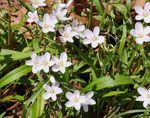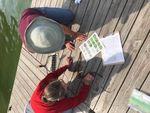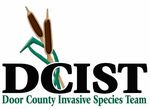The Door County Invasive Species Team
←
→
Page content transcription
If your browser does not render page correctly, please read the page content below
April 2022
The Door County
Invasive Species Team
Empowering Door County citizens and local municipalities with the education, tools,
and skills to tackle invasive species.
The 2022 field season is almost here! And DCIST is looking for your help!
Got Phrag?!
Door County Soil & Water Conservation Department (SWCD) has secured funding
through Wisconsin DNR’s Surface Water Grant program, Forest Service’s Great
Lakes Restoration Initiative program, Fish and Wildlife’s Sustain our Great Lakes
program, and funding through the American Rescue Plan Act funds to address non-
native phragmites on all private properties throughout the County. Funds are
anticipated to last for 5-years. If you know of any non-native phragmites
populations please reach out to DCIST so we can offer this opportunity to any and
all interested private property land owners.
Phragmites is an herbaceous perennial grass. It is an aquatic invader, colonizing riparian, wetland, and shoreline areas. It can
look like other grasses and plants, but an easy diagnostic tool is to look at where the leaves meet the stem. Phragmites will
have prominent white hairs at this juncture. The hairs become more prominent when the leaf is gently pulled away from the
stem. Phragmites can grow up to 20’ tall and becomes more prominent in late summer/fall when the plume flower head forms.
Like most invasive species phragmites has a vast root system that can grow 6’ deep and 10’ wide resulting in a large
underground energy source, making control difficult.
Phragmites consumes a lot of water as it grows and has been documented lowering water levels in wetlands. Phragmites
stands grow densely and quickly, shading out native species and preventing movement through well-established populations.
Its dense stems can alter the flow of water and even clog drainage ditches. Additionally, these changes in hydrology and the
dense impenetrable wall of growth limit water access, impede wildlife movement, alter water fowl habitat, and can decrease
property values. There are a few look alike plants to non-native phragmites including native phragmites. The important
features to differentiate phragmites from other grasses is to look for the prominent white hairs at leaf and stem junctures.
Non-native phragmites can look quite similar to native phragmites. There are many guides to differentiate the two
subspecies. For a direct comparison, search online for the Great Lakes Phragmites Collaborative Identifying Native Vs.
Invasive Phragmites.
For more information about SWCD’s control efforts, to report non-native phragmites, or to learn more about invasive species
in Door County please visit the Doorinvasives.org. To see the current inventory DCIST has please visit the Door County Web
map http://map.co.door.wi.us/map/ click on the Conservation folder to open a drop-down menu and select the Invasive
Plants folder. Under the Invasive Plants drop-down folder toggle the 2021 Phragmites Inventory, check the box and all
populations mapped during last year’s season will be displayed.
Make sure to check us out on Facebook on the Door County Invasive Species (DCIST) page and at our website
https://doorinvasives.org for events, news, and more!Page 2
Invasive Species Workshops and Volunteer Opportunities
Every Day is Earth Day
April 21st-24th
The festival kicks off on Thursday night at Crossroads with a screening of
“Kiss the Ground.” Then on Friday night at Northern Sky’s Gould Theater,
there will be an Earth Day Show featuring live music, prose and poetry.
On Saturday we will host our festival at the Kress with booths and
workshops focused on Earth Care. Finally, the fest will wrap on Sunday
at Crossroads with demonstrations and outdoor activities.
For more information please visit:
https://kresspavilion.org/ededfest/
Garlic Mustard Pull Day
May 17th, 9 am (Rain Date May 18th, 9 am)
Garlic Mustard is one of those noxious weeds the Village of Egg Harbor is
focusing on eradicating. This is a species that blooms in spring and drops around
1,000 seeds per plant in early June.
The program will include a presentation by Sam Koyen from the Door County
Invasive Species Team (DCIST) at the home of Ken & Shawn Mathys.
After a brief presentation, volunteers will head out to tackle a large patch of
Garlic Mustard along County Hwy G, adjacent to the golf course. As time
permits we will branch out to other areas.
For more information please visit:
https://www.villageofeggharbor.org/ or reach out to Tom Strong at
tstrong@villageofeggharbor.org
Clean Boats Clean Waters Training
May 31st, 10-12 am
Ever wonder how to become a boat launch aquatic invasive species
protector or wonder about DCIST’s aquatic invasive species prevention
efforts? Here’s your chance to attend a Clean Boats Clean Water training.
This Clean Boats, Clean Waters training is for those who have never
participated in a Clean Boats, Clean Waters, watercraft inspection, and for
those who would like a reminder and some practice before heading out to
the landings this summer. This FREE training is open to the public. All are
welcome to attend. To register, please contact Samantha Koyen, Door
County AIS Coordinator and Conservationist, at skoyen@co.door.wi.us or
call 920-746-2363.
For more information about Clean Boats Clean Waters please visit:
https://www3.uwsp.edu/cnr-
ap/UWEXLakes/Pages/programs/cbcw/default.aspx
Make sure to check us out on Facebook on the Door County Invasive Species (DCIST) page and at our website
https://doorinvasives.org for events, news, and more!Page 3
Invasive Species Workshops and Volunteer Opportunities
20th Annual Festival of Nature
May 13th- August 6th
The 2022 Festival of Nature offers a full slate of field trips, classes,
and activities throughout Door County. Registration opens Monday,
April 18th at 10am.* There is a maximum number of participants
allowed for each field trip or program, so registering early is the best
way to ensure you get to participate in the activities you want.
Registration is easy – go to www. RidgesSanctuary.org or call 920-
839-2802.
DCIST Summer Training
June 8th 8 am-12 pm
DCIST would like to invite you to a fun filled 4 hour invasive species training
to learn more about field identification, safety, invasive species rules and
regulations, and why protecting Door County from these invasive species is
so important. Various partners will address topics and there will be a field
component so dress appropriately!
For more information about the event reach out to the DCIST coordinator,
Samantha Koyen: Office: 920-746-2363, Email: dcist1@gmail.com
Want to stay up to date on all activities?
Check out the DCIST calendar! The calendar provides up to date events
going on pertaining to natural resource events. If you have an event you
would like to add to the calendar let us know! The website also provides
information on control options, identification information, and so much
more!
Check out our calendar at: https://doorinvasives.org/calendar
DCIST relies on volunteers to help collect data on where invasive plants and animals are found in Door County.
If you’re interested in helping, we can provide training on the use of handheld GPS units or you can also use the GLEDN app
to report findings via your smartphone. Contact DCIST at dcist1@gmail.com for more information or learn how to
download and use the app at https://fyi.uwex.edu/wifdn/.
Keep an eye out for our May newsletter and keep up to date on our DCIST website at https://doorinvasives.org. We will
be posting any and all additional training opportunities & educational materials as we receive them.Page 4
Native Species Highlights
Wisconsin Spring Flowers
Spring in Wisconsin is a beautiful time to see ephemeral species, and stunning spring flowers. Ephemeral species have
a limited time to prosper and blossom before the trees leaf out, earning them the name “ephemeral”, meaning lasting
a short time. Ephemerals and spring flowering native plants provide pollinators with an early source of nectar. Native
species like these support our native ecology. Please help our native species by controlling invasive species and
whenever possible landscape with native species.
Blood root (Sanguinaria candadensis): This ephemeral grows in
undisturbed woodlands, in flood plains, and on slopes near streams
and waterways. When cut this plant exudes a reddish sap living up
to its common name “blood root”.
Spring beauty (Claytonia virginia): This ephemeral can grow in a variety of
habitats including lawns, woodlands, savannahs and pastures, but is most
commonly found in woodland settings.
Hepatica (Hepatica nobilis): This ephemeral flower can be pink, blue or white.
It is found most commonly in woodland settings.
Shadbush/serviceberry (Amelanchier spp.): There are several species of serviceberry
native to Door County, including roundleaf serviceberry (A. sanguinea), inland
serviceberry (A. interior), common serviceberry (A. arborea), and Allegheny
serviceberry (A. laevis). These white flowering shrubs bloom late April into May and
provide small edible berries in June/July earning this shrub it’s other common name
“Juneberry”.
Yellow trout lily (Erythronium americanum): This ephemeral grows most commonly in
woodland settings. There are also white trout lilies (Erythronium albidum) that grow in
Wisconsin.
**Bloodroot photo credits: left-Minnesota Wildflowers/right-Wisconsin DNR, Spring beauty Photo credits: left-Illinois,
Wildflowers/right-Mt. Cuba Center, Hepatica photo credits: left & right-Wisconsin Master Gardener Program UW-
Extension, Shadbush/serviceberry photo credits: left- G.A. Cooper/right- Danny Barron, Trout lily photo credits: left-Lady
Bird Johnson Wildflower Center/right-Minnesota Wildflowers.
Make sure to check us out on Facebook on the Door County Invasive Species (DCIST) page and at our website
https://doorinvasives.org for events, news, and more!Page 5
A Stinky Invader!
Invasive Plant Profile: Garlic Mustard (Alliaria petiolata ) An invader of Door county
Garlic mustard (Alliaria petiolata) is an herbaceous biennial, meaning it has a two-year life
cycle, when crushed the plant smells like garlic earning its name “garlic mustard.” Garlic
mustard was introduced by early European settlers, they brought the plant over to use as
an herb and for medicinal purposes. In current times, the rise of the “if you can’t beat it,
then eat it” movement has resulted in some people going back to eating this invasive
species, most commonly as pesto sauce.
Characteristics of garlic mustard, such as its high seed production (one plant can produce
up to 8,000 seeds), early seasonal growth, allelopathic qualities (the ability for it to modify
soil components), and ability to tolerate a variety of open and wooded habitats, wetlands, 1st year garlic mustard rosette
old fields, and disturbed areas allows the plant several advantage over Wisconsin’s native photo taken by Kelly Kearns
plants. Impacts of garlic mustard invasions include negative impacts to wildlife food
sources, loss of wildlife habitat, altering soil characteristics to prohibit other plant species
from growing, and loss of native species.
During the first year of growth garlic mustard forms a rosette (leaves that grow in a
circular arrangement close to the ground) of round, scalloped-margined leaves that stay
semi-evergreen through the winter. During the second and final year of its life cycle,
plants sends up a flower stem with triangular toothed leaves that has tiny four- petaled
white flowers. The plant dies after producing long narrow seedpods. Second year garlic
mustard plants may be 3 to 4 ft tall, while first year plants are a low growing ground
cover.
Mechanical methods such as hand-pulling can be effective on small populations/plants if
care is taken to remove as much of the root system as possible. Controlled burns can be
effective to control populations as well. For more dense or established populations,
chemical control in the form of foliar treatment may be most effective. Recent studies 2nd year garlic mustard flowers
photo taken by Wisconsin DNR
suggest competitive plantings after control efforts have proven successful in suppressing
existing seed banks. For more information please visit UW – Extension Renz Weed Lab’s
Garlic Mustard information page at
https://cdn.shopify.com/s/files/1/0145/8808/4272/files/A3924-07.pdf.
Garlic mustard is listed as a Restricted species under NR-40. Restricted species are those
that are already present throughout the state of Wisconsin and are not likely to be
eradicated even though they are likely to cause significant environmental and economic
harm or harm to human health. The NR 40 Rule makes it illegal to transport, transfer, or
introduce invasive species listed as restricted in Wisconsin. If you suspect you have garlic
mustard on your property, contact DCIST for identification or for more information on 2nd year garlic mustard with seed
what you can do to halt invasion of exotic plants on your land. Remember if you find pods photo taken by Elizabeth J.
invasive species in Door County, be sure to report it to DCIST or use the GLEDN app! Czarapata
The Door County Invasive Species Team – Samantha Koyen, Coordinator
DCIST Message Line: 920-746-5955; Email: dcist1@gmail.com
Check out our new website at https://doorinvasives.orgYou can also read



























































